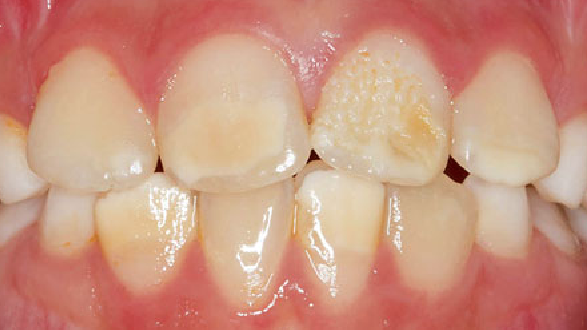Calcium deficiency in cells due to ORAI1 gene mutation leads to damaged tooth enamel

Last Updated on May 15, 2019 by Joseph Gut – thasso
April 28, 2019 – Calcium deficiency in cells due to ORAI1 gene mutation leads to damaged tooth enamel. That is the sec notion stemming from the outcome of a study published April 23 in Science Signaling, stating that a mutation in the ORAI1 gene, which was studied in a human patient and in mice, leads to a loss of calcium in enamel cells and results in defective dental enamel mineralization. The researchers identified ORAI1 as the dominant protein for calcium influx into enamel cells (Ameloblasts) and revealed the mechanisms by which calcium influx affects enamel cell function and the formation of tooth enamel.

Calcium is critical for many cellular functions, including mineralizing teeth and bones. Calcium enters cells via ORAI proteins, which form pores in a cell’s plasma membrane to enable calcium influx when activated. Studies have shown that several genes, including ORAI (which encode ORAI proteins), are involved in the formation of tooth enamel. Enamel, the hard, outer layer of teeth, first forms as a soft, gel-like matrix. ORAI proteins then help the enamel-forming cells to mineralize.
Mutations in the human ORAI1 gene result in immune dysfunction and immune diseases, but people with ORAI1 mutations also have defects in their tooth enamel. In the present study, the researchers investigated the case of a patient with a complex medical history, including combined immunodeficiency and a mutation in the ORAI1 gene. Throughout his childhood, the patient had defects on his tooth enamel, resulting in severe cavities and related dental abscesses. Based on his clinical presentation, the researchers concluded that the ORAI1 mutation likely accounted for the defective enamel mineralization.
Because the lack of dental samples from patients with ORAI1 mutations, the researchers then developed mouse models to study the role of ORAI proteins in enamel formation, both by observing tooth enamel and examining its influence on the environment inside enamel cells.
The researchers studied the ORAI family of proteins (ORAI1, ORAI2, and ORAI3) and genetic mutations in the corresponding genes to investigate the mechanism by which calcium is modulated by each of these proteins. When mice had a mutation in the ORAI1 gene and were therefore deficient in ORAI1 protein, calcium entry into enamel cells was significantly reduced (by roughly 50 percent), and tooth enamel was abnormal, including cracks in the outer enamel layer. By contrast, mice with ORAI2 mutations and ORAI2 deficiency showed an increase in calcium by approximately 30 percent in the enamel cells, which did not result in obvious enamel defects. This suggests that ORAI1 is the dominant channel for modulating the influx of calcium into enamel cells.
To better understand how calcium influx, and conversely, deficiency in calcium, changes the functioning of enamel cells, the researchers examined the activity of cells lacking ORAI1. They found that calcium dysregulation in ORAI1-deficient cells affects their function at multiple levels, including increased mitochondrial respiration and subsequent changes in redox balance. An elevation in reactive oxygen species can be detrimental to cells, and to protect proteins in an intracellular environment that is more oxidizing, a mechanism called S-glutathionylation is promoted. The findings provide a foundational understanding of what happens in enamel cells, which could help create a pathway for researchers interested in regenerating tooth enamel or developing therapies to treat patients with enamel defects.
The take home message for patients who suffer from defects on their tooth enamel, resulting in severe cavities and related dental abscesses is that there exist molecular and genetic backgrounds which may lead to the suffered sequelae. The common popular assumption that the “bad teeth” result from inadequate dental hygiene and/or consumption of sugar does as such not stand anymore. These letters behaviours may, however, aggravate the seriousness of a dental condition for which the molecular/genetic predisposition described above exists. It would also to be of particular interest to know how many individuals in the population are carrying the ORAI1-mutations, either as heterozygotes or as homozygotes. Future research in the epidemiology of enamel defects will certainly reveal this kind of information.
There are some other rather exiting new informations available and emerging on the topic of genetic backgrounds on enamel development and diseases behind it, such as, for example, on the whole exome sequencing that identifies an AMBN missense mutation which causes severe autosomal-dominant amelogenesis imperfecta and dentin disorders. Frankly speaking, I never thought that “bad teeht” could have such an exiting genetic background.
See here a short sequence on Ameliogensis:
Related posts
Lemtrada: Deleterious unwanted effects in some multiple sclerosis patients
Pioglitazone: Too often ending in bladder cancer?
Risk of severe if not fatal skin reactions with Pembrolizumab (Keytruda)
Is there rapid management of 500 (rare) genetic diseases?
eHealth: Viz.AI Contact App to alert for stroke in patients
Ph.D.; Professor in Pharmacology and Toxicology. Senior expert in theragenomic and personalized medicine and individualized drug safety. Senior expert in pharmaco- and toxicogenetics. Senior expert in human safety of drugs, chemicals, environmental pollutants, and dietary ingredients.

